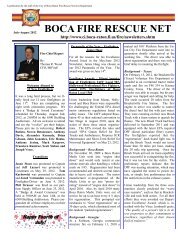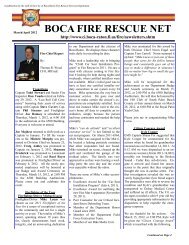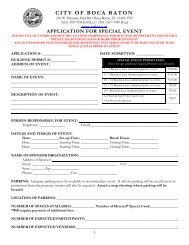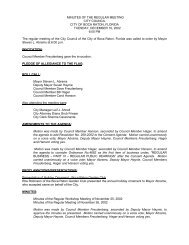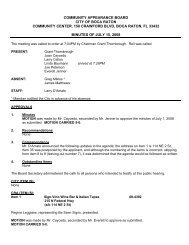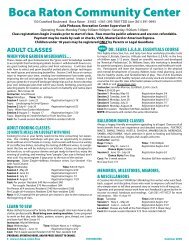ENGINEERING DESIGN STANDARDS MANUAL - City of Boca Raton
ENGINEERING DESIGN STANDARDS MANUAL - City of Boca Raton
ENGINEERING DESIGN STANDARDS MANUAL - City of Boca Raton
You also want an ePaper? Increase the reach of your titles
YUMPU automatically turns print PDFs into web optimized ePapers that Google loves.
11.0 Harbors, Docks, Bulkheads and Seawalls<br />
The design, layout <strong>of</strong> Harbors, docks, bulkheads and seawalls are recommended to be performed by<br />
experienced engineers and should be closely coordinated by the Engineer <strong>of</strong> Record with the <strong>City</strong> Civil<br />
Engineer.<br />
Boat travel in coastal waters is a public right established through the commerce clause <strong>of</strong> the U.S.<br />
Constitution which gives the Congress regulatory power over navigable waters—an authority that has<br />
been delegated to the U.S. Army Corps <strong>of</strong> Engineers (USACE).<br />
Design parameters shown in the <strong>City</strong> <strong>of</strong> <strong>Boca</strong> <strong>Raton</strong> has a Marine Structures Code and the MILITARY<br />
HANDBOOK SEAWALLS, BULKHEADS, AND QUAYWALLS, US Navy, which can be used by the<br />
engineer for reference.<br />
12.0 Livable Communities<br />
It is the policy <strong>of</strong> the <strong>City</strong> to consider Transportation Design for Livable Communities (TDLC) features<br />
on the city roadways when such features are desired, appropriate and feasible. This involves providing a<br />
balance between mobility and livability. TDLC features should be based on consideration <strong>of</strong> the<br />
following principles:<br />
1. Safety <strong>of</strong> pedestrians, bicyclists, motorists and public transit users.<br />
2. Balancing community values and mobility needs.<br />
3. Efficient use <strong>of</strong> energy resources.<br />
4. Protection <strong>of</strong> the natural and manmade environment.<br />
5. Coordinated land use and transportation planning.<br />
6. Local and state economic development goals.<br />
7. Complementing and enhancing existing design standards, systems and processes.<br />
On-street parallel parking is preferred over angled parking on low speed urban streets. Angled parking<br />
causes conflicts with cars and bicycles, since drivers have poor visibility when backing out. Parallel<br />
parking can provide space for bike lanes, medians and wider sidewalks. The design <strong>of</strong> parking facilities<br />
should be coordinated with local transit agencies.<br />
- 22 -



